Dialysis is a procedure by which waste products and excess water that accumulate in renal failure are removed from the body artificially. It is a life-saving technique for patients with End Stage Kidney Disease (ESKD) or Acute Kidney Injury.
How does dialysis help people with severe kidney failure?
Dialysis helps the body by performing the following functions of failed kidneys:
- Purification of blood by removal of waste products such as creatinine, urea etc.
- Removal of excess fluid and maintenance of the right amount of water in the body.
- Correction of electrolyte and acid-base balance disturbances.
However, dialytic therapy cannot replace all the functions of a normal kidney such as production of the hormone erythropoietin needed to maintain hemoglobin levels.
When is dialysis needed?
When the kidney function is reduced by 85-90% from the normal (ESKD) waste products and fluids build up in the body. The accumulation of toxins such as creatinine and other nitrogenous waste products leads to symptoms such as nausea, vomiting, fatigue, swelling and breathlessness. These are collectively termed as uremia. At this point, medical management becomes inadequate and the patient will need to start dialysis.
Can dialysis cure chronic kidney disease?
No. Chronic kidney disease is irreversible and once a patient reaches Stage 5 (ESKD), lifelong dialysis treatments will be needed unless successful kidney transplantation is performed. On the other hand, a patient with AKI may need dialysis support only for a short period until kidney function recovers.
Dialysis is a prompt and effective treatment modality in symptomatic patients with severe kidney failure.
What are the types of dialysis?
There are two main types of dialysis : hemodialysis and peritoneal dialysis.
Hemodialysis: In hemodialysis (HD), waste products and excess fluids
are removed from the blood by passing the blood through a special
filter or artificial kidney called a dialyzer, aided by a dialysis machine.
Peritoneal dialysis: In peritoneal dialysis (PD), a soft tube or catheter
is inserted through the skin, into the abdominal cavity and dialysis solution
is infused into the abdominal cavity to remove waste products and excess
fluid from the body. This is done at home, usually without a machine.
Which factors determine selection of dialysis modality in
ESKD patients?
Hemodialysis and peritoneal dialysis both are effective modalities in
ESKD patients. No single dialysis modality is best suited for all patients.
After considering advantages and disadvantages of each dialysis
modality, selection of HD or PD is made jointly by the patient, family
members and the nephrologist. Major factors determining this selection
are cost of therapy, age, comorbid conditions, distance of hemodialysis
center, educational status, physician bias and the patient’s preferences
and lifestyle. Because of low cost and easy availability, hemodialysis is
preferred by a large number of patients in India.
Dialysis can not cure kidney failure, but helps patients to
live comfortably in spite of kidney failure.
Do dialysis patients need to restrict their diet?
Yes. Common dietary recommendations for dialysis patients are
restriction of sodium, potassium, phosphorus and fluid intake. Dialysis
patients must follow these dietary advices but dietary restrictions are
reduced after dialysis is initiated in CKD. Most patients on dialysis are
advised to take more protein compared to their pre-dialysis
prescriptions, with adequate calories, water-soluble vitamins and
minerals. It is advisable that patients on dialysis consult a dietitian to
adequately plan their diets.
What is “dry weight”?
In patients undergoing dialysis, the “dry weight” is the weight of the
patient after all excess fluid is removed by dialysis. The “dry weight”
may need to be adjusted from time to time as the actual weight of the
patient may change. This is also known as the edema-free weight, the
patient has no lung congestion and the hemodynamic status is not
compromised (BP is not low nor do they have any symptoms).
Even after starting dialysis, dietary
restrictions must be continued.
In hemodialysis, blood is purified with the help of dialysis machine and
dialyzer.
How is hemodialysis done?
Most of the time, hemodialysis is performed in hospitals or free standing
dialysis centers, under the care of doctors, nurses and dialysis
technicians.
- The dialysis machine pumps blood from the body to the dialyzer
through flexible blood tubings. Heparin infusion or continuous saline
flushing is done to prevent clotting of blood.
62. Save Your Kidneys
- The dialyzer (artificial kidney) is a special filter through which blood
flows which removes extra fluids and waste products. Dialyzer
purifies blood with the help of special solution called dialysate which
is prepared by a dialysis machine.
- Once the blood is cleaned, the machine sends it back to the body.
- Hemodialysis is carried out usually three times per week and each
session lasts for about four hours.
How is the blood withdrawn for purification and returned back
to the body in the process of hemodialysis?
The three most common types of vascular access for hemodialysis are
central venous catheters, native arteriovenous (AV) fistulas and synthetic
grafts.
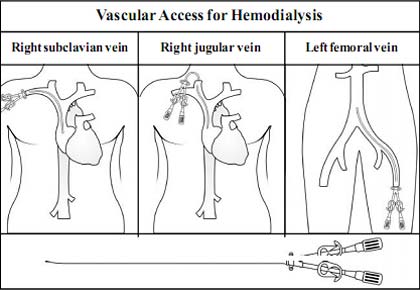 1. Central Venous Catheter
1. Central Venous Catheter
As soon as the decision to start immediate hemodialysis is made, a
vascular access or central venous catheter has to be inserted. The
vascular access will allow the blood of the patient to leave the body
and be brought to the artificial kidney or dialyzer to be cleaned or
filtered.
This method of vascular access is ideal for short-term use until a fistula or graft is ready.
A catheter is inserted into a large vein in either the neck, chest, or leg near the groin (internal jugular, subclavian and femoral veins respectively). With this catheter more than 300 ml/min blood can be withdrawn for dialysis.
Catheters are flexible, hollow tubes with two lumens. Blood leaves the patient’s body passing through one lumen, enters the dialysis circuit, and is returned to the body via the other lumen.
Venous catheters are immediate but temporary accesses for hemodialysis especially on emergency cases.
Two types of venous catheters are available, tunnelled (usable for months) and non-tunnelled (usable for weeks).
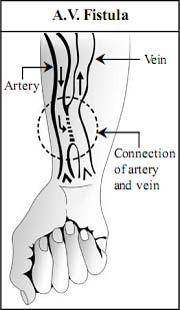 2. AV Fistula
2. AV Fistula
The arteriovenous or AV fistula is the most common and the best method of vascular access for long term hemodialysis because it lasts longer, & is less likely to get clotted or inflected.
An AV fistula is created in the forearm near the wrist by surgically connecting or apposing the radial artery to the cephalic vein.
Since blood flow and pressure is higher in the artery than the vein, blood flows from the former to the latter. After a few weeks or months, the vein dilates and its walls thickens.
Such maturation of the AV fistula takes time, hence, it cannot be used for hemodialysis immediately after its construction.
For hemodialysis two large-bore needles are inserted into the fistula, one to carry blood to the dialyzer and the other to return the cleansed blood to the body.
AV fistula lasts for many years if maintained well. All usual daily activities can be easily performed with the hand having AV fistula.
Why does AV fistula need special care?
- Life of a patient with CKD- ESKD depends on regular and adequate hemodialysis. The AV fistula is the permanent vascular access essential for chronic hemodialysis and is also called the lifeline for the patient on maintenance hemodialysis. Special care of AV fistula ensures adequate blood delivery for a long period.
- Large amount of blood with high pressure flows in the veins of AV fistula. Accidental injury to such dilated veins can lead to profuse bleeding, and sudden loss of blood in large volume can be life threatening. So special care is mandatory to protect veins of AV fistula.
Taking Care of AV Fistula
Proper regular care and protection of AV fistula ensures adequate blood delivery for years. Important precautions to keep a fistula healthy and working for longer period are as follows:
1. Prevent infection
Always keep the site of the fistula clean by washing the vascular access arm daily and before each dialysis treatment. It is also important to observe aseptic technique during cannulation and throughout the dialysis process.
AV fistula is the “lifeline” in patients of CKD, without which long term hemodialysis is not possible.
CHP. 13. Dialysis 65.
2. Protecting the AV fistula
- Use access site only for dialysis. Do not let anyone give intravenous
injections, draw blood or measure blood pressure on the arm with
the AV fistula.
- Avoid injury to AV fistula. Don’t wear jewelry, tight clothes or a
wrist watches on the vascular access arm. Accidental injury to AV
fistula can lead to sudden profuse bleeding, which can be life-
threatening.
- To control bleeding, immediately apply firm pressure at the site of
the bleeding with the other hand or with a tight bandage. After the
bleeding is controlled, contact your doctor. Instead of making efforts
to control the loss of blood, rushing to hospital for help is unwise
and dangerous.
- Do not lift heavy items with the accessed arm and avoid pressure on
it. Be careful; do not sleep on the arm with the A V fistula.
3. Ensure proper functioning of AV fistula
Blood flow through the AV fistula should be checked regularly by feeling
the vibration (also called a thrill) three times a day (before breakfast,
lunch and dinner). If the vibration is absent, your doctor or dialysis
center staff should be immediately contacted. A blood clot may have
formed inside the fistula and early detection and timely intervention to
dissolve or remove the clot may salvage the AV fistula.
- Low blood pressure carries the risk of failure of AV fistula, and
therefore, should be prevented.
4. Regular exercise
Regular exercise of AV fistula can lead to its maturation. Even after
66. Save Your Kidneys
initiating hemodialysis, regular exercise of access arm helps to strengthen the AV fistula.
3. Graft
- An arteriovenous graft is another form of long term dialysis access, which can be used when persons do not have satisfactory veins for an AV fistula or have a failed AV fistula.
- In graft method, an artery is surgically connected to a vein with a short piece of synthetic soft tube which is implanted under the skin. Needles are inserted in this graft during dialysis treatment.
- Compared to an AV fistula, AV grafts are at a high risk to develop clotting, infection, and usually do not last as long as a fistula.
To ensure adequate blood delivery and effective long term
hemodialysis, special care of AV fistula is most essential.
What are the functions of hemodialysis machine?
- The machine prepares special dialysis solution (dialysate), which is delivered to the dialyzer for cleaning of the blood.
- The machine meticulously adjusts and monitors concentration of electrolytes, temperature, volume and pressure of delivered dialysate, which are modified as per the patient’s need. Dialysis solution removes unwanted waste products and extra water from the body through dialyzer.
- For the safety of the patient, the machine has various safety devices and alarms such as for detection of blood leakage from the dialyzer or the presence of air in blood circuit.
- Computerized models of hemodialysis machine with display of various parameters on front screen and different alarms provide convenience, accuracy and safety to perform and monitor dialysis treatment.
The hemodialysis machine, with the help of dialyzer, filters blood and maintains fluid, electrolyte and acid base balance.
CHP. 13. Dialysis 67.
What is the structure of the dialyzer and how does it purify blood?
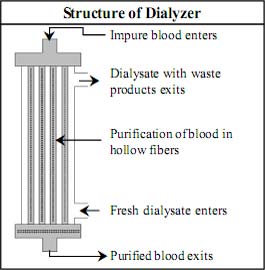 Structure of dialyzer
Structure of dialyzer
In the process of hemodialysis , dialyzer (artificial kidney) is a fi lter where purification of blood occurs.
Dialyzer is about 20 centimeter long and 5 centimeter wide clear plastic cylinder which contains thousands of tube-like hollow fibers composed of synthetic s emi - p e rme a b l e membrane.
These hollow fibers are connected with each other at upper and lower end of the cylinder and form the “blood compartment.” Blood enters in the “blood compartment” of hollow fibers from the opening or blood port from one end and exits from the other end after purification.
Dialysis solution enters from one end of dialyzer, flows around the outside of the fibers (“dialysate compartment”) and exits from the other end.
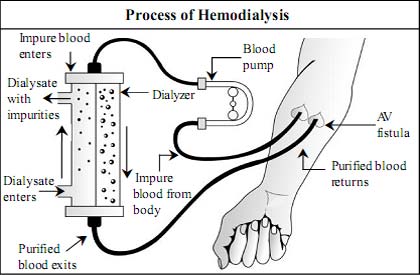 Purification of blood in dialyzer
Purification of blood in dialyzer
In hemodialysis, blood flows out from the patient through the vascular access and blood tubings into one end of the dialyzer where it is distributed into thousands of capillary-like hollow fibers. The dialysis solution enters from another port and flows around these fibers in the “dialysate compartment” of the dialyzer.
Every minute, about 300 ml of blood and 600 ml of dialysis solution continuously flow in opposite directions within the dialyzer. The semi-permeable membrane of the hollow fibers which separates the blood and the dialysate allows removal of waste products and excess fluid from the blood to the dialysate compartment.
Blood exits from the other end of dialyzer after purification. Dialysis solution with toxic substances and excess fluid which are removed from the blood exits from the end of dialyzer from which blood enters.
In hemodialysis, the blood volume of the patient circulates and passes through the dialyzer about twelve times. After four hours of treatment, blood urea and serum creatinine levels are reduced substantially, excess fluids are removed and electrolyte levels are corrected.
What is dialysate and its function in hemodialysis?
- The dialysate (dialysis solution) is the special fluid used in hemodialysis to remove waste and extra fluid from the blood.
- The composition of the standard dialysate resembles normal extracellular fluid, but depending on the need of the patient, its composition can be modified.
CHP. 13. Dialysis 69.
- The dialysate is prepared by manufacturer by mixing about 30 parts of highly purified water with one part of dialysate concentrate.
- The dialysate concentrate is a special fluid that is commercially available, which contains electrolytes, minerals and bicarbonate.
- The water used to make the dialysate is purified sequentially by a sand filter, a charcoal filter, water softener, reverse osmosis, deionization and ultraviolet filtration. The product of these processes is water that is essentially free of dust, suspended impurities, chemical impurities, minerals, bacteria and endotoxins.
- This careful purification of water and subsequent monitoring of its quality is essential to protect patients from the risk of contaminants in the water. Each patient is exposed to about 150 liters of water during each hemodialysis session.
Where is hemodialysis done?
Hemodialysis is usually done in hospitals or dialysis centers by trained staff under the supervision of a doctor. In a few stable patients, it may be done at home. Home hemodialysis requires proper training of the patient and family members, adequate space and financial resources.
Is hemodialysis painful? What does the patient do during dialysis?
The hemodialysis procedure is not painful. There may be slight pain experience during intravenous needle insertion when the blood tubings are connected to the patient at thestart of the procedure. This outpatient requires the patient to go to the hospital or dialysis center thrice a week and going home afterwards. During the treatment, patients rest, sleep, read, listen to music or watch television. They may even take light snacks and hot or cold drinks during this time.
What are the common problems during hemodialysis?
Common problems during hemodialysis include low blood pressure (hypotension), nausea, vomiting, muscle cramps, weakness and headache. These adverse events may be avoided by appropriately accessing the hemodynamics and volume status before the dialysis session. Weight gain in between sessions should be monitored, as well as serum electrolytes and hemoglobin levels.
Changes in dialysate composition helps correct electrolyte imbalance and during the process of hemodialysis.
What are the advantages and disadvantages of hemodialysis? Advantages of hemodialysis:
- Since treatments are done by trained nurses or technicians, patients are subjected to less burden of caring for themselves. Some patients find hemodialysis more comfortable and less stressful than peritoneal dialysis.
- Hemodialysis is faster and more efficient per unit time than peritoneal dialysis.
- Hemodialysis center provides a platform to meet and interact with other patients with similar problems. Such interaction can reduce stress and the patient can enjoy company of fellow patients.
- Hemodialysis is usually done for 4 hours, three times a week. Between treatments, patient may enjoy “free time”.
- Patients avoid the risks of peritonitis and exit-site infections.
- In some countries, hemodialysis is less expensive than peritoneal dialysis.
The main advantages of hemodialysis are safety, effectiveness and comfort.
CHP. 13. Dialysis 71.
Disadvantages of hemodialysis:
- Inconvenience and time lost for regular travel to the hemodialysis center especially when the latter is located far from home.
- Due to fixed schedule for hemodialysis, the patient has to plan all activities around the treatment schedule.
- Frequent needle pricks and insertion during treatments can be painful. There are some measures like application of topical anesthetics to diminish the pain in some cases.
- Dietary restrictions of fluid, salt, potassium and phosphorous still have to be observed. Patients need to adhere to these limitations .
- There is a risk of contracting blood-borne infections like Hepatitis B and C.
Do’s and don’ts for hemodialysis patients
- Patients with ESKD on maintenance hemodialysis need regular treatments, usually thrice weekly. Skipping or missing treatments are deleterious to health.
- Hemodialysis patients have to observe proper dietary restrictions. Fluid, salt, potassium and phosphorous restriction have to be observed. Protein intake should be regulated upon the advice of the doctor or renal dietician. Ideally, weight gain between dialysis should be kept at 2 to 3 kgs (4.4 to 6.6 lbs) only.
- Malnutrition is common in patients on hemodialysis and leads to poorer outcomes. A referral to a dietician with the supervision of the doctor is necessary to maintain enough caloric and protein intake to maintain adequate nutrition.
72. Save Your Kidneys
- Patients on maintenance hemodialysis may need to be supplemented with water-soluble vitamins like vitamins B and C. They should avoid over-the-counter multivitamins which may not contain some required vitamins, may contain inadequate levels of some required vitamins, or may contain vitamins that may be harmful for CKD patients such as vitamins A, E and K.
- Calcium and vitamin D may be supplemented, depending on blood levels of calcium, phosphorus and parathyroid hormone.
- Lifestyle changes are mandatory. General measures include smoking cessation, maintenance of ideal weight, regular exercise and limitation of alcohol intake.
The main disadvantage of hemodialysis is the need to visit a center three times a week.
When should a patient on hemodialysis consult a dialysis nurse or doctor?
The patient on hemodialysis should immediately consult a dialysis nurse or doctor in cases of :
- Bleeding from AV fistula site or catheter site.
- Disappearance or absence of vibration, bruit or thrill in the AV fistula.
- Unexpected weight gain, significant swelling or breathlessness.
- Chest pain, very slow or fast heart rate.
- Development of severe high blood pressure or low blood pressure.
- Confusion, drowsiness, unconsciousness or convulsions.
- Fever, chills, severe vomiting, vomiting of blood or severe weakness.
In patients with hemodialysis restriction of fluids and salt is essential to control weight gain between two dialysis.
CHP. 13. Dialysis 73.
Peritoneal dialysis (PD) is another form of dialysis modality for the patients with kidney failure. It is widely accepted and effective. It is the most common method of dialysis done at home.
What is peritoneal dialysis?
- The peritoneum is a thin membrane that lines the inner surface of the abdominal cavity.
- The peritoneal membrane is a natural semi-permeable membrane which allows waste products and toxins in the blood to pass through it.
- Peritoneal dialysis is a process of purification of blood through the peritoneal membrane.
What are the types of peritoneal dialysis?
Types of peritoneal dialysis:
- Intermittent Peritoneal Dialysis (IPD)
- Continuous Ambulatory Peritoneal Dialysis (CAPD)
- Continuous Cycling Peritoneal Dialysis (CCPD)
1. Intermittent Peritoneal Dialysis (IPD)
Intermittent peritoneal dialysis (IPD) is a valuable and effective dialysis option for short term dialysis in hospitalized patients with acute kidney failure, in children and during emergencies or initial treatment of ESKD. In IPD, a special catheter with multiple holes is inserted into the patient’s abdomen through which a special solution called the dialysate is infused into the abdominal cavity or peritoneal space. The dialysate absorbs waste products and excess fluids from the patient’s blood. After some time, the fluid is drained and the process is repeated several times in a day.
- IPD lasts for a period of 24- 36 hours and about 30 to 40 liters of dialysate solution is used up during the treatment.
- IPD is repeated at short intervals of 1 -3 days, as per the need of the patient.
CAPD is a type of dialysis that can be carried out by patients at home with specialized fluid.
74. Save Your Kidneys
2. Continuous Ambulatory Peritoneal Dialysis (CAPD) What is CAPD?
CAPD means :
C – Continuous: The process is uninterrupted (treatment without stopping for 24 hours a day, 7 days a week).
A – Ambulatory: The patient can walk around and performroutine activities.
P – Peritoneal: The peritoneal membrane in the abdomen works as a filter.
D – Dialysis: The method of purification of blood.
Continuous Ambulatory Peritoneal Dialysis (CAPD) is a form of dialysis which can be carried out by a person at home without the use of a machine. As CAPD provides convenience and independence it is a popular dialysis modality in many countries.
Process of CAPD :
CAPD catheter:The permanent access for peritoneal dialysis (CAPD catheter) is a soft thin flexible silicon rubber tube with numerous side holes. It is surgically inserted into the patient’s abdomen through the abdominal wall, about an inch below and to the side of the navel or belly button. The CAPD catheter is inserted about 10 to 14 days before CAPD starts. The PD catheter is the “life line” of CAPD patients, just as the AV fistula is to a patient on hemodialysis.
Technique of continuous ambulatory peritoneal dialysis (CAPD):
In CAPD, special fluid (dialysate) is infused into the abdominal cavity and is kept there for a period of time, after which it is drained. This process of fill, dwell and drain is called an exchange.
CHP. 13. Dialysis 75.
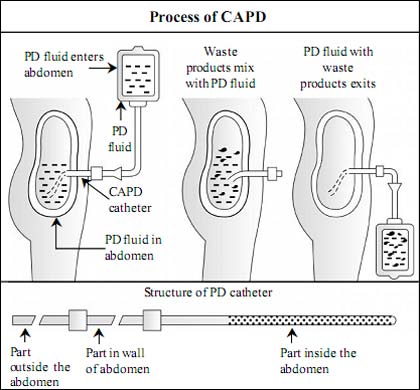 Fill: Peritoneal dialysis fluid from the sterile PD bag is infused by gravity, through sterile tubings connected to the PD catheter, into the abdominal cavity. Usually, 2 liters of fluid is infused. The bag emptied of PD fluid is rolled up and tucked in the patient’s inner wear until the next exchange.
Fill: Peritoneal dialysis fluid from the sterile PD bag is infused by gravity, through sterile tubings connected to the PD catheter, into the abdominal cavity. Usually, 2 liters of fluid is infused. The bag emptied of PD fluid is rolled up and tucked in the patient’s inner wear until the next exchange.
Dwell: The period of time in which PD fluid remains inside the abdominal cavity is called the dwell time. This lasts for about 4 to 6 hours per exchange during the day and 6 to 8 hours at night. The process of cleaning the blood takes place during dwell time. The peritoneal membrane works like a filter allowing waste products, unwanted substances and excess fluid to pass from blood into the PD fluid. The patient is free to walk around during this time (hence the term, ambulatory).
Drain:When the dwell time is completed, the PD fluid is drained into the empty collection bag (which had been rolled up and tucked in the patient’s inner clothing). The bag with the drained fluid is weighed and discarded; the weight is recorded. The drained fluid should be clear. Drainage and replacement with fresh solution takes about 30 to 40 minutes. Exchanges may be done from 3 to 5 times during the day and once during the night. Fluid for the night exchange is left in the abdomen overnight and drained in the morning. Strict aseptic precautions should be observed when performing CAPD.
CAPD must be carried out meticulously every day at a fixed time with no holidays.
76. Save Your Kidneys
3. APD or Continuous Cycling Peritoneal Dialysis (CCPD):
Automated peritoneal dialysis (APD) or continuous cycling peritoneal dialysis (CCPD) is a form of PD treatment done at home using an automated cycler machine. The machine automatically fills and drains the PD fluid from the abdomen. Each cycle usually lasts for 1-2 hours and exchanges are done 4 to 5 times per treatment. The treatment lasts about 8 to 10 hours, usually at night, while the patient is asleep. In the morning, the machine is disconnected and 2 to 3 liters of PD fluid are usually left in the abdominal cavity. This fluid is drained the following evening before the next treatment is started. APD is advantageous since it allows the patient to go about regular activities during the day. Also, since the PD bag is connected and detached from the catheter only once a day, the procedure is more comfortable and carries less risk of peritonitis. However, APD may be expensive in some countries and can be a rather complex procedure for some patients.
What is PD fluid used in CAPD?
PD fluid (dialysate) is a sterile solution containing minerals and glucose (dextrose). Glucose in the dialysate allows removal of fluid from the body. Depending on the concentration of glucose, there are three kinds of dialysate available in India and in most areas worldwide (1.5%, 2.5% and 4.5%).The glucose concentration is selected for individual patients depending on the amount of fluid that needs to be removed from the body. Newer PD fluids are available in some countries which contain icodextrin instead of glucose. Icodextrin-containing solutions remove body fluids more slowly and are recommended for diabetic or overweight patients.
CAPD solution bags are available in different volumes ranging from 1000 to 2500 ml.
Continuous Cycling Peritoneal Dialysis is carried out at home with an automated cycler machine.
CHP. 13. Dialysis 77.
What are the common problems during CAPD?
The main complications of CAPD involve infections. The most common infection is peritonitis, an infection of the peritoneum Pain in the abdomen, fever, chills and cloudy/turbid outflow of PD fluid (effluent) are common presentations of peritonitis. To avoid peritonitis, CAPD should be done under strict aseptic precautions and constipation should be avoided. The treatment of peritonitis includes broad spectrum antibiotics, culture of the PD effluent (to help select appropriate antibiotics) and, in a few patients, removal of the PD catheter. Infection at the exit site of the PD catheter is another infection that may also develop.
Precautions to avoid infections are of utmost importance in CAPD patients.
Other problems that may occur in CAPD are abdominal distention, weakening of the abdominal muscles causing hernia, fluid overload, scrotal edema, constipation, back pain, poor outflow drainage, leakage of fluid and weight gain.
Precautions to avoid infections are of utmost importance in CAPD patients.
78. Save Your Kidneys
Advantages of CAPD
- Dietary and fluid restrictions are less, compared to hemodialysis treatment.
- More freedom is enjoyed, since PD can be done at home, at work or while travelling. The patient can perform CAPD on his or her own and there is no need for a hemodialysis machine, hemodialysis nurse, technician or family member to help out. Other activities may be done while dialysis is taking place.
- The fixed schedule of hospital or dialysis center visits, travel time and needle pricks associated with hemodialysis are avoided.
- Hypertension and anemia may be better controlled.
- Gentle dialysis with continuous cleaning of blood, so no ups-and- downs or discomfort.
Disadvantages of CAPD
- Infections of the peritoneum (peritonitis) and catheter exit site are common.
- The treatment may be stressful. Patients should perform treatments regularly every day, without fail, meticulously following instructions and strict cleanliness.
- Some patients experience discomfort and changes in appearance due to the permanent external catheter and fluid in the abdomen.
- Weight gain, elevated blood sugar and hypertriglyceridemia may develop due to absorption of sugar (glucose) in the PD solution.
- PD solution bags may be inconvenient to handle and store at home.
What dietary changes are recommended for a patient on CAPD?
- A patient on CAPD requires adequate nutrition and the dietary prescription is slightly different from the diet of patients on hemodialysis.
- The doctor or dietician may recommend increasing protein in the diet to avoid protein malnutrition due to continuous protein loss in peritoneal dialysis.
- Enough calories should be ingested to prevent malnutrition while avoiding excessive weight gain. The PD solution has glucose which adds continuously extra carbohydrate to patient on CAPD.
- Although salt and fluid still have to be restricted, there may be less restriction than for a patient on hemodialysis.
- Dietary potassium and phosphate are restricted.
- Dietary fiber is increased to prevent constipation.
Main benefits of CAPD are freedom in location, convenience in timings and lesser dietary restrictions.
CHP. 13. Dialysis 79.
When should a person on CAPD contact the dialysis nurse or doctor?
The patient on CAPD should immediately contact dialysis nurse or doctor when any of the following occurs:
- Pain in abdomen, fever or chills.
- Drainage of cloudy/turbid or bloody PD fluid.
- Pain, pus, redness, swelling or warmth around exit site of CAPD catheter.
- Difficulty in infusion or drainage of PD fluid.
- Constipation
- Unexpected weight gain, significant swelling, breathlessness and development of severe hypertension (suggestive of fluid overload).
- Low blood pressure, weight reduction, cramps and dizziness (suggestive of fluid deficit).
Patients on CAPD must take high protein diet to avoid malnutrition and reduce risk of infection.